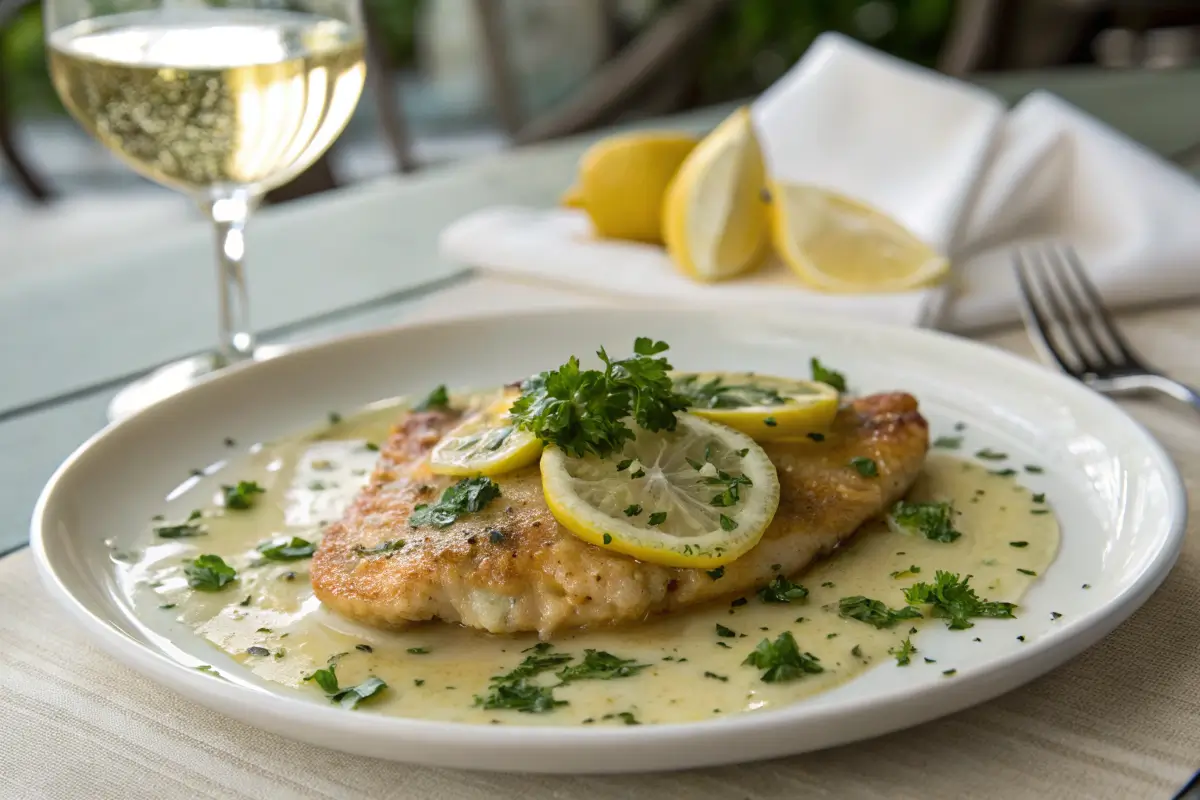Ready to explore the rich history and savory secrets behind one of the most beloved Italian-American dishes? In this article, we’ll dig into the linguistic history of Chicken Francese, its flavorful components, and the culinary traditions that shaped it. We’ll also contrast it with similar dishes like Chicken Française, delve into the role of French-style cooking methods, and reveal important tips for creating that crispy exterior, velvety sauce everyone craves. By the end, you’ll understand the origins of this classic chicken recipe and discover, once and for all, Why is it called Chicken Francese?
Throughout the sections ahead, we’ll share credible insights on its name, origins, and variations within Italian-American cuisine. We’ll break down its essential ingredients, look at nutritional aspects, and even explore healthy twists. Besides, we’ll provide clear steps for making the dish in your own kitchen. So, let’s waste no more time! Get ready for a comprehensive journey into a restaurant menu staple that has captured hearts and taste buds around the world.
Introduction to Chicken Francese
Setting the Stage for “Why Is It Called Chicken Francese?”
Chicken Francese has charmed diners for decades with its simple yet decadent blend of lemon butter sauce and tender chicken cutlets. It’s an Italian-inspired dish that often sparks confusion around its name, especially since “Francese” suggests a French connection.
Nevertheless, this delightful entree stands as a symbol of the fusion between Italian tradition and American innovation. Its popularity soared alongside other favorites like Chicken Marsala and Chicken Piccata, but many food lovers continue to ask: Why is it called Chicken Francese?
Brief Overview of Chicken Francese’s Popularity
In countless restaurants, Chicken Francese appears as a staple, from local diners to upscale eateries. Its approachable flavor and elegant presentation make it a go-to menu item for those who enjoy a mouthwatering white wine sauce but prefer a lighter twist compared to heavier cream-based dishes.
The Essence of the Dish: Lemon, Wine, and Butter
The star of Chicken Francese is the vibrant sauce made from fresh lemon juice, dry white wine, and a bit of butter. This mixture creates a zesty finish that complements the chicken’s mild taste, drawing in diners who crave a tangy, comforting meal.
Try This Delicious Feta Vegetable Bake Recipe for a Healthy Twist
Add a nutritious and flavorful dish to your menu with this easy Feta Vegetable Bake.
The Origin Story Behind Why Is It Called Chicken Francese?
Uncovering “Why Is It Called Chicken Francese?” from Culinary History
Many people wonder, Why is it called Chicken Francese? Especially when the name seems to hint at a French background. However, the path leading to this classic chicken recipe is deeply tied to Italian-American cuisine. During the early waves of Italian immigration, families carried their homeland’s traditions while relying on locally available ingredients in America.
Moreover, chefs sensed the allure of French-style cooking methods and began blending them into new dishes, resulting in an exciting fusion. Consequently, Chicken Francese was born from those cross-cultural experiences, becoming a beloved entrée across restaurants nationwide.
Italian-American Influence
Italian immigrants often adapted recipes from various regions of Italy, finding common ground in simpler techniques. Hence, their approach to preparing chicken cutlets quickly with lemon juice and white wine gave rise to something special. This streamlined process, popular in Italian-American kitchens, eventually shaped the notable features of Chicken Francese.
Early Mentions in American Cookbooks
Interestingly, early 20th-century cookbooks started hinting at pan-fried chicken bathed in a lemon butter sauce. Nonetheless, it took time for Chicken Francese to be widely recognized under its modern name. Gradually, different authors picked up on this dish, locking its status as a restaurant menu staple.
The Franco-Italian Connection
Despite its solid roots in immigrant culinary adaptation, Chicken Francese also showcases subtle hints of French influence. Consequently, it’s no surprise that some perceive it as a Franco-Italian hybrid that flourished in American settings.
The Possible French Culinary Techniques
French cuisine is known for refined sauces that rely on butter and wine, so Italian-American cooks possibly drew inspiration from these elements. Here, using white wine and thickening with flour underscores those Gallic underpinnings.
Immigrant Adaptations
Though rooted in age-old Italian styles, immigrants fused local produce with French touches. As a result, Chicken Francese became an entirely new phenomenon championed by Italian-American communities for its bright, tangy taste.
Indulge in Maggiano's Recipes – Italian Classics
Explore a collection of Maggiano's recipes featuring timeless Italian classics that delight every palate.
Etymology of “Francese”
Linguistic Roots Explained
Digging deeper into Why is it called Chicken Francese? reveals that “Francese” stems from the Italian word for “French.” While that might sound straightforward, the real story is more nuanced. In Italian, “alla Francese” translates to “in the French style,” nodding to a method of preparation that borrows techniques from France. Likewise, many older recipes indicate the term could’ve been attached simply to make the dish sound elegant, as French cooking was often considered sophisticated.
The Meaning of “Francese” in Italian
In basic terms, “Francese” literally means “French.” However, gastronomic history suggests that Italian cooks may have used the title to reference a sauce or cooking style reminiscent of French cuisine. By blending crispy chicken with a white wine sauce, they achieved a flavor profile that seemed more refined.
Evolution of the Dish Name
Over the years, the name evolved. Sometimes called “Chicken Française,” it gradually took shape in various kitchens across the United States. Furthermore, some restaurants labeled it “Chicken French” to appeal to local tastes. Regardless, the central concept remained intact: tender chicken, lemon, and a luscious sauce.
Cultural and Language Intersections
The melding of French, Italian, and American influences within Chicken Francese is no accident. Essentially, it’s a testament to cross-cultural creativity in bustling immigrant communities.
Influence of French vs. Italian Language
Although the dish’s foundation is Italian, that touch of French flair boosted its popularity among American diners. Moreover, sprinkling in a few linguistic twists helped the recipe stand out in a competitive culinary landscape.
Regional Variations or Alternate Spellings
Some places spell it “Chicken Française,” while others use “Chicken French.” Nevertheless, each variation points back to the same delightful meal. Over time, these differences only highlighted the dish’s flexibility, paving the way for modern expansions and personal renditions.
Enjoy Restaurant-Quality Maggiano's Chicken Piccata at Home
Bring the flavors of Maggiano's Chicken Piccata to your own kitchen with this easy recipe.
Historical Culinary Context
Comparing Chicken Francese to Similar Dishes
Many people who enjoy Italian-American cuisine also gravitate toward Chicken Piccata and Chicken Marsala. Yet, they often pause to ask, “Why is it called Chicken Francese?” when these other dishes appear so familiar. Indeed, Chicken Francese shares similarities with those neighboring recipes, but it sets itself apart through its rich use of lemon butter sauce combined with a gentle coating of eggs and flour. Consequently, diners experience a softer bite compared to sharper flavors found in Piccata or the deeper wine notes in Marsala.
Chicken Piccata
Traditionally, Chicken Piccata uses capers to impart a tart and briny twist. Meanwhile, Chicken Francese leans on bright lemon juice and a hint of wine for its characteristic taste. Though both rely on a tangy sauce, Piccata’s defining element centers on capers, giving it a saltier, more piquant flair.
Chicken Marsala
On the other hand, Chicken Marsala incorporates sweet Marsala wine, which contributes a richer essence. While it occasionally shares a velvety texture, its flavor profile tends to be fruitier. Thus, Chicken Francese’s citrus-forward sauce remains a refreshing contrast for those looking for a lighter bite.
Restaurant Popularity Timeline
Uptick in 1970s and 1980s
Throughout the 1970s and 1980s, Chicken Francese origin stories flourished in restaurant kitchens. Patrons loved the dish’s quick prep time and delightful blend of lemon and butter. Consequently, Italian-American establishments continued showcasing it on their menus, further cementing its status as a restaurant menu staple.
Modern-Day Variations
In modern times, creative chefs add twists like fresh herbs or capers, though their general approach remains the same. Therefore, Chicken Francese continues to thrive, reflecting a timeless combination of immigrant culinary adaptation and French-inspired cooking.
Savor a Classic with This Chicken Piccata Maggiano's Recipe
Recreate the traditional Chicken Piccata as perfected by Maggiano's Little Italy.
Ingredients & Preparation Methods

Traditional Components in Why Is It Called Chicken Francese?
Although the dish’s name has sparked curiosity, its essential elements are straightforward. Remarkably, only a handful of ingredients create this classic chicken recipe. Consequently, home cooks love how easily they can assemble everything. Additionally, the process evokes a sense of nostalgic warmth, reflecting the best of Italian-inspired dishes.
Flour, Eggs, and Chicken Cutlets
Firstly, you’ll need chicken cutlets, typically pounded thin for quicker, more even cooking. Next, a simple flour mixture helps form the crispy exterior. Afterward, dipping the cutlets into lightly beaten eggs locks in moisture, resulting in a tender bite with a delicate crust.
Lemon, Butter, and White Wine
Moreover, the lemon butter sauce remains vital to Chicken Francese. Mixing fresh lemon juice, dry white wine, and a generous pat of butter creates a tangy yet smooth finish. Notably, this sauce is where the French-style cooking methods shine through, making the dish taste both light and elegant.
Step-by-Step Classic Approach
Knowing how to prepare this entrée is half the fun. Meanwhile, it’s quite straightforward once you gather the correct ingredients.
Pan-Frying vs. Sautéing
Although both methods produce delectable results, pan-frying typically uses a bit more oil, ensuring an extra-crispy finish. Conversely, sautéing with minimal oil suits those desiring a lighter meal.
Secrets to Achieving the Perfect Sauce
Finally, remember to deglaze the pan with wine, stirring up any browned bits. Thus, you’ll unlock deep layers of flavor. Topping off the sauce with butter just before serving creates a velvety consistency, enhancing every morsel of your chicken cutlets in the final dish.
Explore the Rich Flavors of Chicken Marsala Maggiano's Style
Dive into the savory world of Chicken Marsala with this authentic Maggiano's-style recipe.
Nutritional Perspective on Chicken Francese
Caloric Breakdown and Health Considerations
On the surface, Chicken Francese may appear light and fresh thanks to its lemon butter sauce, yet it can still carry a fair number of calories. Often, the classic chicken recipe involves pan-frying chicken cutlets in oil before swirling them in butter.
Consequently, the total fat content can add up. However, many diners remain curious about Why is it called Chicken Francese? despite the caloric load. That question goes hand in hand with its cultural roots, blending French-style cooking methods and Italian-American cuisine.
Furthermore, the white wine used in the sauce can contribute extra calories, though most chefs use small amounts. Nonetheless, moderation remains key. Incorporating more vegetables on the side can help balance out the meal.
Additionally, swapping refined pasta for whole-grain noodles or choosing light bread could make a noticeable difference in daily nutrient intake.
The Role of Butter and Oil
Butter often elevates the flavor, though it also increases saturated fat. Meanwhile, using olive oil or avocado oil can reduce the presence of unhealthy fats. Moreover, controlling the amount of oil used can significantly impact the overall calorie count.
Possible Ingredient Substitutions
For those watching their diet, substituting low-sodium chicken stock for part of the white wine can lower both salt and alcohol content. Subbing out some of the butter for a cornstarch slurry might still give the sauce a velvety finish without excess fat. By managing portion sizes and carefully choosing ingredients, Chicken Francese can become a healthier, balanced meal.
Making It Lighter: Healthy Twists
When aiming to lighten up your Chicken Francese, simple strategies go a long way. Rather than piling on butter, clever ingredients add complex flavors minus the guilt.
Baked Chicken Francese
Baking instead of pan-frying reduces added oil while still producing a crisp exterior. After coating the chicken in flour and egg, place the pieces on a parchment-lined tray. Toss them in the oven until they turn golden, which preserves both taste and texture without a greasy outcome.
Low-Fat or Gluten-Free Adaptations
In addition, using gluten-free flour blends ensures those with sensitivities can still enjoy this classic chicken recipe. Substituting low-fat yogurt for part of the butter or egg can further cut calories. Consequently, you’ll savor a guilt-free rendition of Chicken Francese that emphasizes flavor over indulgence.
Discover the Authentic Taste with Our Chicken Francese Maggiano's Recipe
Enhance your culinary skills by trying out this classic Chicken Francese recipe inspired by Maggiano's Italian cuisine.
Flavor Profiles and Serving Suggestions

Pairing Chicken Francese with Side Dishes
Because this Italian-inspired dish boasts tangy and buttery notes, picking the right sides truly matters. In fact, pairing it with fresh or savory accompaniments highlights the sauce’s bright citrus qualities.
That said, people still wonder Why is it called Chicken Francese? only to discover it has roots in immigrant culinary adaptation and French-style cooking methods. Yet, when selecting sides, the main goal is to keep the focus on the lemon butter sauce without overwhelming one’s palate.
Pasta, Rice, or Vegetables
Pasta remains a classic choice, as it calmly holds extra sauce. Alternatively, a bed of rice can soak up any leftover wine-infused flavors. On the other hand, lightly seasoned steamed vegetables like broccoli or zucchini add a fresh burst that contrasts nicely with the slightly rich sauce.
Complementary Salad and Bread Options
If you’re craving something lighter, a crisp salad with mixed greens can offset the dish’s richness. Furthermore, tossing in some cherry tomatoes or olives contributes balanced acidity. For extra comfort on cooler nights, pairing Chicken Francese with warm garlic bread or crusty rolls completes the meal’s cozy feel.
Wine Pairings for Chicken Francese
Winemaking tradition runs deep in Italian and French cuisine, so choosing a suitable wine ensures a cohesive culinary experience.
Crisp White Wines
A bright Sauvignon Blanc or Pinot Grigio usually accentuates the lemon undertones. They also cleanse the palate, cutting through the buttery sauce.
Regional Italian Wines
Alternatively, a light Verdicchio or Soave can showcase subtle fruit hints that mesh beautifully with Chicken Française. As a result, you’ll discover new depths of flavor while enjoying this restaurant menu staple, celebrating both tradition and modern taste.
Regional Variations & Modern Toppings
American Variations of Chicken Francese
In the United States, Why is it called Chicken Francese? remains a common question, despite the dish’s long-standing presence. Over time, home cooks and restaurant chefs have personalized this classic chicken recipe to suit local palates, adding unexpected twists and flavors. Even though the dish started within the realm of Italian-American cuisine, Americans embraced it wholeheartedly. Eventually, they developed various regional takes that highlight local produce and preferences.
Creamy Sauce Additions
Countless restaurants have experimented with creating a creamier version of Chicken Française. By adding a dash of heavy cream or half-and-half to the lemon butter sauce, they produce a richer texture without completely masking the tangy wine undertones. As a result, diners enjoy a comforting entrée that marries brightness with velvety elegance.
Using Herbs and Spices
Elsewhere, adventurous cooks jazz up the standard recipe by incorporating fresh herbs like basil or thyme. In some regions, a pinch of paprika or red pepper flakes adds a subtle kick. Indeed, these small changes can invigorate the dish, ensuring it remains a restaurant menu staple beloved by patrons who crave novelty.
Restaurants’ Signature Twists
Eateries often set themselves apart by introducing unique, mouthwatering innovations. They might pour in bold flavor while still preserving the basic bones of the French-style cooking methods.
Adding Capers or Artichokes
Some chefs borrow elements from Chicken Piccata by adding capers, elevating the salty layer that complements bright lemon tones. Others fold in artichoke hearts for added texture and a mild tang, blending seamlessly with the buttery sauce.
Infusing Extra Flavor with Spicy Elements
Occasionally, kitchens introduce chili flakes, jalapeños, or even sriracha into the sautéing step. This infusion of heat pleases adventurous eaters eager to explore fresh variations while retaining the essential characteristics that define Chicken Francese.
FAQs
Is Chicken Francese Really Italian or French?
While the title suggests French alignment, the dish largely belongs to Italian-American cuisine. In truth, immigrant culinary adaptation guided its creation. Nonetheless, its French-style cooking methods blend seamlessly with Italian traditions, contributing to the confusion.
Can I Use Other Meats for Francese?
You can absolutely experiment with different meats. Veal or fish can create tasty alternatives, following the same basic recipe and white wine sauce.
How Is Chicken Francese Different from Chicken Piccata?
Even though they share a bright lemon base, Chicken Francese relies on an egg dip to form its soft crust. Chicken Piccata focuses on capers and a sharper sauce profile.
What Is the Easiest Way to Make Chicken Francese Kid-Friendly?
Cut back on strong acids (like too much lemon) or alcohol (subbing with broth) to help kids enjoy the dish.
How do you say chicken francese in Italian?
In Italian, “chicken francese” is called “pollo alla francese”, which translates to “chicken in the French style.” The word “pollo” means chicken, and “alla francese” means “in the French manner.” This name reflects the dish’s preparation method, which incorporates techniques associated with French cuisine.
Is chicken francese the same as Piccata?
The main differences are the egg batter in Chicken Francese and the use of capers in Chicken Piccata. These variations result in distinct textures and flavor profiles, making each dish unique despite their similarities.
What’s the difference between chicken Milanese and chicken francese?
The key differences are in the breading and the presence of sauce. Chicken Milanese is breaded with breadcrumbs and is crispy, served without a sauce, focusing on the chicken’s texture. Chicken Francese has an egg-only coating without breadcrumbs and is served with a flavorful lemon butter sauce. These distinctions make each dish unique in Italian and Italian-American cuisine, offering different dining experiences.
Conclusion
Reflecting on “Why Is It Called Chicken Francese?”
Ultimately, Why Is It Called Chicken Francese? can be traced to its fusion of French-style cooking methods and Italian-American cuisine. Although it boasts a crisp exterior and a tangy lemon butter sauce, it remains grounded in immigrant culinary adaptation. Over time, it has evolved into a classic chicken recipe that many families now cherish for both its simplicity and irresistible taste.
The Cultural Tapestry of the Dish
Indeed, this entrée stands at the crossroads of cultural exchange, bridging Italian heritage and French elegance. Each region has developed its own spin, yet the goal always circles back to preserving its tender, buttery character. Despite subtle differences, the foundation of white wine sauce and bright citrus endures.
The Future of This Italian-American Classic
As food trends continue to shift, Chicken Francese will likely remain a restaurant menu staple. With endless opportunities for creative updates, it promises to delight taste buds for generations to come.






